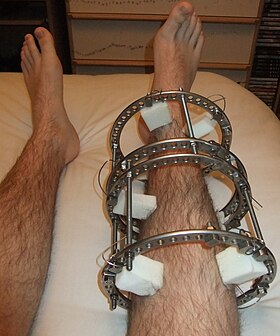External fixation
| External fixation | |
|---|---|
| Intervention | |

An Ilizarov apparatus is a type of external fixation used to treat limb deformities.
|
|
| ICD-9-CM | 78.1, 79,93.51-93.56, 93.59 |
| MeSH | D016267 |
External fixation is a surgical treatment used to stabilize bone and soft tissues at a distance from the operative or injury focus. They provide unobstructed access to the relevant skeletal and soft tissue structures for their initial assessment and also for secondary interventions needed to restore bony continuity and a functional soft tissue cover.
The parts of an external fixator include:
1. Schanz pin
2. Connecting rods
3. Clamps.
In this kind of reduction, holes are drilled into uninjured areas of bones around the fracture and special bolts or wires are screwed into the holes. Outside the body, a rod or a curved piece of metal with special ball-and-socket joints joins the bolts to make a rigid support. The fracture can be set in the proper anatomical configuration by adjusting the ball-and-socket joints. Since the bolts pierce the skin, proper cleaning to prevent infection at the site of surgery must be performed.
Installation of the external fixator is performed in an operating room, normally under general anesthesia. Removal of the external frame and bolts usually requires special wrenches and can be done with no anesthesia in an office visit.
External fixation is usually used when internal fixation is contraindicated- often to treat open fractures, or as a temporary solution.
External fixation is also used in limb lengthening. People with short limbs can have, for example, legs lengthened. In most cases the thigh bone (femur) is cut diagonally in a surgical procedure under anesthesia. External fixator pins or wires (as above) are placed each side of the 'man made fracture' and the external metal apparatus is used to very gradually push the two sides of the bone apart millimetre by millimetre day by day and week by week. Bone will gradually grow into the small gap created by this 'distraction' technique. Such a process can take many months. In most cases it may be necessary for the external fixator to be in place for many weeks or even months. Most fractures heal in between 6 and 12 weeks. However, in complicated fractures and where there are problems with the healing of the fracture this may take longer still. It is known that bearing weight through fracture by walking on it, for example, with the added support of the external fixator frame actually helps fractures to heal.
Almost 2400 years ago Hippocrates described a form of external fixation to splint a fracture of the tibia. The device consisted of closely fitting proximal and distal Egyptian leather rings connected by four wooden rods from a cornel tree.
In 1840, Jean-Francois Malgaigne described a spike driven into the tibia and held by straps to immobilise a fractured tibia. In 1843 he used a claw-like device to percutaneously hold the fragments of a fractured patella.
Clayton Parkhill of Denver, Colorado and Albine Lambotte of Antwerp, Belgium independently invented the modern concept of unilateral external fixation, in 1894 and 1902, respectively. Lambotte was the first to use threaded pins, however, his device necessitated initial, open fracture reduction and then pin insertion and fixator placement.
...
Wikipedia
